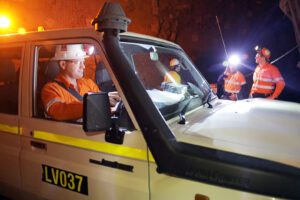SPECIAL INTERVIEW WITH DR KEN PIDD
How common is it for mining sector employees to arrive at work under the influence of drugs or alcohol?
There is no Australian data on how common it is for mining employees to attend work under the influence of alcohol or drugs, but recent Australian research indicated that only a very small proportion of the workforce (including mining sector employees) have attended work under the influence of alcohol (5.6%) or drugs (2%). However, many more employees drink to intoxication or use illicit drugs away from the workplace. For example, nearly 30% of the mining workforce regularly (at least once a month) drink 6 or more standard drinks, while around 12% of the mining workforce have used some type of illicit drug in the past 12 months.
Alcohol and drug use that occurs away from the workplace can also negatively affect workplace safety and productivity. For example alcohol intoxication can result in hangover effects that can continue to negatively affect performance long after Blood Alcohol Levels have returned to zero and heavy alcohol use can disrupt deep (REM) sleep and result in fatigue the day after drinking. Similarly the hangover effects of amphetamine use can last for several days after use and can include fatigue, aggression, mood swings and depression.
Is drug and alcohol abuse more prevalent in FIFO (fly in, fly out) mine workers than in locally-based mine workers?
There is little evidence to indicate that alcohol or drug use is more prevalent among FIFO workers compared to locally based workers, however their patterns of consumption may differ substantially. Some FIFO workers are more likely to be employed at mine sites that are geographically remote from any town or community. In such cases alcohol and drugs are less available and as such the prevalence of consumption among these workers may be very low when they are on site. However, they are more likely to engage in heavy drinking and drug use when they are on leave in their home towns. Their home towns are likely to be large cities where illicit drugs are more readily available and they may believe they can avoid detection by ceasing use in the few days before returning to the mine site. Mine workers who are based in small mining towns however, may have more access to alcohol via the local hotel and are able to drink after completing their shift, so drinking patterns may be more regular. Drug use may be less prevalent among these workers as illicit drugs may be less available in small mining towns (or dealing may be more obvious) or workplace drug testing may be more frequent as these workers may work shorter on/off rosters.
Are shift workers more likely to abuse drugs and alcohol than 9 to 5 workers?
The research evidence generally indicates that alcohol and drug use is more prevalent among shift workers than 9-5 workers. There are two main reasons for this. First, there is likely to be less supervision and management presence on afternoon or night shifts and as such use during work hours or coming to work under the influence or affected by hangover is less detectable. Second, workers can resort to alcohol or drug use to mediate the psychological and physiological effects of shift work. For example shift work can disrupt sleep patterns so workers may resort to using some form of stimulant (amphetamine or prescribed medication such as dexamphetamine) to help wake them up or some form of depressant (alcohol, cannabis, or prescribed medication such as valium) to help them sleep.
What impact does a drug or alcohol-impaired worker have on the safety of a mine site?
Alcohol and drug intoxication has obvious implications for safety in any workplace including high safety risk workplaces such as mine sites. This is especially the case for alcohol and drugs such as cannabis that have a depressant effect on the central nervous system. Alcohol intoxication, for example can have a negative effect on reaction times, muscle function, attention, vision and judgement and reasoning. Similarly, cannabis can slow reaction times and negatively affect psychomotor skills and the ability to focus and concentrate. However while the intoxicating effects of alcohol or drugs can have the most obvious implications for safety, it is also important to remember that the hangover effects, as I’ve just outlined, also have implications for workplace safety.
Is there evidence to suggest workplace drug and alcohol testing improves overall safety?
Workplace alcohol and drug testing can be a useful tool when managing alcohol and drug related risk to safety and productivity. However, research evidence concerning the efficacy of testing in improving safety is scarce and much of what is available is of poor quality. Published reviews of this research generally conclude that there is insufficient evidence to indicate testing is effective. Many of the claims that testing has a substantial impact on workplace safety are largely based on anecdotal evidence, rather than the results of rigorous and methodologically sound evaluation studies. There is some evidence to indicate that workplace testing programs, when combined with comprehensive education and training, can have a positive effect on workplace safety. However, in many workplaces the education and training that accompany testing are restricted to education and training about the testing process itself. To be effective education and training programs should not only explain the testing policy and procedures, but extend to raising employees’ awareness of alcohol and drug related risk to health and safety and build their capacity to respond to this risk.
One of the potential limitations to workplace testing is that employees can change their behaviour to avoid a positive test, rather than change their behaviour to reduce alcohol and drug related risk to safety. They can do this in several ways. Apart from substituting the sample with a clean drug free sample (in the case of urinalysis), employees can shift from using drugs with a long window of detection (eg cannabis) to using drugs with a shorter window of detection (eg amphetamines). This has occurred in the mining industry where a much large proportion of employees use amphetamines compared to employees of industries where testing is less common. Alternatively, employees can change from illicit drug use to the use of prescribed drugs that have similar effects. Such drug use can also be detected by workplace testing, but the use of prescribed drugs is more easily explained as legitimate. Employees can also shift to the use of so called ‘legal drugs’ such as synthetic cannabis such as ‘spice’ or amphetamine like substances such as ‘Jack3D’ in the belief these drugs are less detectable by workplace testing. The use of such drugs among mining employees has grown exponentially over the last few years with sometimes fatal consequences. Recently a West Australian miner died after consuming Jack3D with alcohol and the coronial inquest into the death found the miner had consumed Jack3D instead amphetamine because he feared a positive workplace drug test.
“…shift work can disrupt sleep patterns so workers may resort to using some form of stimulant (amphetamine or prescribed medication such as dexamphetamine) to help wake them up or some form of depressant (alcohol, cannabis, or prescribed medication such as valium) to help them sleep.”
What demographic of worker is more likely to be under the influence of drugs and alcohol in the workplace?
Workers most likely to be under the influence of alcohol or drugs in the workplace and most likely to drink at risky levels or use drugs in general are males aged 20-29 years who are employed in blue collar occupations or as tradespersons.
Are there any drugs, such as synthetic cannabis, that are not able to be detected by current forms of drug testing being employed at mine sites?
Workplace drug tests were developed to detect the most commonly used illicit drugs such as cannabis and amphetamines. These tests are designed to detect either the active chemical in the drug or the inactive metabolites created when the body breaks down the active chemical. While synthetic cannabis such as ‘spice’ and amphetamine like stimulants such as ‘Jack3D’ are designed to mimic the intoxicating effects of these drugs, the active chemicals in synthetic drugs differ. Thus standard workplace drug tests used to detect cannabis or amphetamines will not detect synthetic cannabis or synthetic stimulant use.
Until relatively recently there was no workplace drug test that could detect synthetic drugs, but it appears advances in drug screening technology have resulted in new workplace tests that can. However, it must be remembered the development of this drug test took several years after synthetic drugs were identified as a problem and more than 12 months after the first generation of synthetic cannabis was declared illegal. It is likely that new forms of synthetic cannabis and synthetic stimulants will be developed that are less detectable and drug testing technology will continually lag behind such developments. Already a new form synthetic cannabis has reportedly emerged called ‘Venom’ that is being promoted as being more potent and less detectable than first generation synthetic cannabis.
Is there any evidence to suggest that workplace education campaigns have any effect on drug and alcohol abuse in the workforce?
Research evidence indicates that workplace drug testing is most effective when combined with comprehensive education and training programs. There is also evidence to indicate that education and training on its own can have an effect. Recent US research identified that drug testing on its own can have a deterrent effect on worker drug use. This same research found that education and training programs that did not involve testing had a similar deterrent effect. Moreover, an additional benefit of good quality and comprehensive education and training programs is that they contribute to the wider health and safety culture and help build management and supervisory skills.
“Until relatively recently there was no workplace drug test that could detect synthetic drugs, but it appears advances in drug screening technology have resulted in new workplace tests that can.”
PROFILE
Dr KEN PIDD
 Dr Ken Pidd is the Deputy Director (Research) at the National Centre for Education and Training on Addiction (NCETA) at Flinders University and has worked in the alcohol and drug field for the past 15 years.
Dr Ken Pidd is the Deputy Director (Research) at the National Centre for Education and Training on Addiction (NCETA) at Flinders University and has worked in the alcohol and drug field for the past 15 years.
Prior to working at NCETA, Dr Pidd managed a drug and alcohol program for the South Australian construction industry and has an ongoing research and practice interest in the area. He provides advice and consultancy on managing workplace alcohol and drug issues for government agencies, unions, employer and industry groups as well as individual employers.













Add Comment